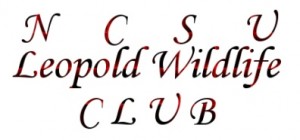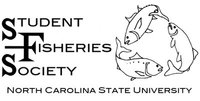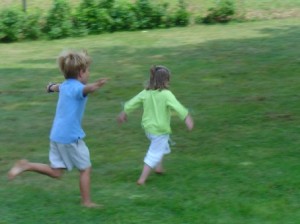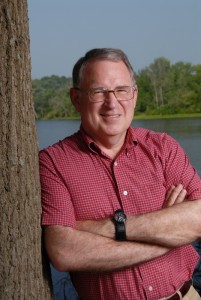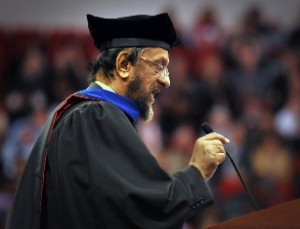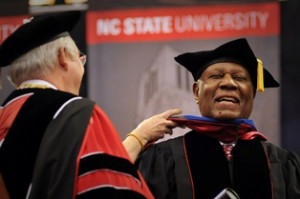NCSU SAF Student Chapter goes to Hawaii for the 2012 SAF National Convention and a Wilderness Leadership Experience – Life Lessons Learned in Paradise
By Lauren Lesak, Stephen Kinane, Jay Dysart with cameo roles by Mike Cheston, Aaron Boyd, Ed Hull, Sam Honeycutt, AnneMargaret Braham and Joe Roise
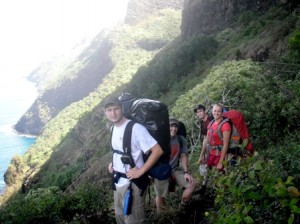 Going to Hawaii was definitely an experience of a lifetime. To start with, this was the first time several of us had ever flown. From the start we were very excited, and did not know what we were getting into. Something as simple as carrying our luggage was a challenge due to the fact that we had convention and wilderness gear, 5 days’ worth of food and it weighed a lot! Thankfully, Dr. Roise knew what we were getting into and had us more or less prepared for what was about to happen. Our flight plan was Raleigh to Dallas to Honolulu to Lihue on Kauai. Once we got seated in Raleigh the plane quickly took off. Lauren was very nervous about flying and seeing this everyone began teasing her and holding barf bags while laughing. She wanted to laugh, but was too busy bracing herself for takeoff. We went through some turbulence which freaked Lauren out a little, but it was all good. We landed in Dallas with a little more life experience than we started with.
Going to Hawaii was definitely an experience of a lifetime. To start with, this was the first time several of us had ever flown. From the start we were very excited, and did not know what we were getting into. Something as simple as carrying our luggage was a challenge due to the fact that we had convention and wilderness gear, 5 days’ worth of food and it weighed a lot! Thankfully, Dr. Roise knew what we were getting into and had us more or less prepared for what was about to happen. Our flight plan was Raleigh to Dallas to Honolulu to Lihue on Kauai. Once we got seated in Raleigh the plane quickly took off. Lauren was very nervous about flying and seeing this everyone began teasing her and holding barf bags while laughing. She wanted to laugh, but was too busy bracing herself for takeoff. We went through some turbulence which freaked Lauren out a little, but it was all good. We landed in Dallas with a little more life experience than we started with.
We were starving once we got off the plane for a stop-over in Dallas, so we ate at an Irish restaurant and had a very filling breakfast including black and white pudding (blood and fat, yuck). The flight to Honolulu was much more relaxing due to the bigger size, free blanket, and free entertainment. Lauren was now experienced and taking off was no big deal this time. However, after 4 hours on an 8 hour flight, we were beginning to get cabin fever and extremely restless and all we could see was water.
Finally we were flying over the Hawaiian Islands. We were so excited. The view was awesome. When we landed, we changed into wilderness clothing and looked for food (some of us were always looking for food). We finished eating and headed to the seating area for the plane to Kauai. We were getting sleepy. It was around 7PM in Honolulu but 1AM in Raleigh. The flight to Kauai lasted about 20 minutes from takeoff to landing. Walking into the airport at Lihue Kauai was like entering another world. The Airport was mostly open and some Hawaiians were singing and doing the hula. They really made us feel welcomed. It was like we belonged. Taxi drivers then picked us up for the drive to the Na Pali Wilderness trailhead, and finally got to our camp site around 11PM. We set up camp in the dark, next to the ocean and quickly fell to sleep.
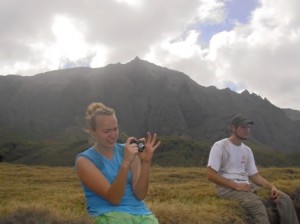 The next morning, we woke up to roosters crowing at the crack of dawn. Chickens were running lose all around us. Getting out of our tents we saw the Pacific Ocean in front of us, palm trees all around us and a 1000+ foot cliff behind us. We ate a delicious breakfast of poptarts and headed towards the trail. Back in Raleigh, Roise had told us that the Kalalau Trail in the Na Pali Wilderness was ranked as one of the most difficult and dangerous trails in the US. None of us really believed that and we did not realize how difficult it was going to be until we got to the trail itself. Most of us were thinking this was going to be a piece of cake, but boy were we wrong.
The next morning, we woke up to roosters crowing at the crack of dawn. Chickens were running lose all around us. Getting out of our tents we saw the Pacific Ocean in front of us, palm trees all around us and a 1000+ foot cliff behind us. We ate a delicious breakfast of poptarts and headed towards the trail. Back in Raleigh, Roise had told us that the Kalalau Trail in the Na Pali Wilderness was ranked as one of the most difficult and dangerous trails in the US. None of us really believed that and we did not realize how difficult it was going to be until we got to the trail itself. Most of us were thinking this was going to be a piece of cake, but boy were we wrong.
It rained, on and off, throughout the hike, and every so often, we would stop to rest and revive ourselves with a snack. The guys ate everything they had in the first mile. We hiked for several miles and decided to stop for lunch at a mosquito infested jungle underneath coffee and mango trees. Unfortunately, the mangoes were not ripe this time of year. Everyone devoured their pita sandwich like they had never eaten in their life before. We discovered that when hungry ham, cheese and peanut butter makes a delicious meal. We continued to hike through muscle cramps and dehydration until mile 6 where we made camp.
We set up camp on an ancient terrace Hawaiians built for taro farming. Then we went to a stream and swam under a waterfall yelling “I’m a Hawaiian polar bear”. Supper that night consisted of Dr. Roise’s jambalaya, which was amazing! We were sound asleep by around 7PM.
Spam and crackers was our morning breakfast. Might sound yucky, but this was definitely a good idea because the salt content in the Spam kept us going (Spam is a favorite in Hawaii). The next part of the trail was dangerous at times and was kind of sketchy, but the view was unbelievable. On one of the sections of the trail, we saw a guy in a kayak and we all yelled aloha, not knowing that we would meet up with him later. Mike and Ed repeated over and over how they would have a boat pick us up at the end of the trail and take us back to civilization. They were so hopeful; we started to believe it might happen.
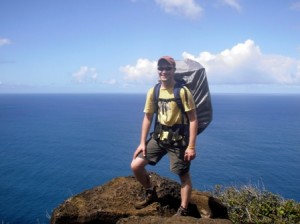 We finally made it to the camp site at Kalalau Beach. We set up our tents and headed to the beach. We had made it to tropical paradise. Later we went to look for oranges. After walking a mile or so we ended up at a camp occupied by an old guy with a long white bread, missing most his teeth, wearing raggedy clothes, and he talked pretty chill. He was the guy in the kayak we yelled aloha to from up on the cliff. His name was Grizzly. We got an invitation to the native Halloween party and for volleyball the next day.
We finally made it to the camp site at Kalalau Beach. We set up our tents and headed to the beach. We had made it to tropical paradise. Later we went to look for oranges. After walking a mile or so we ended up at a camp occupied by an old guy with a long white bread, missing most his teeth, wearing raggedy clothes, and he talked pretty chill. He was the guy in the kayak we yelled aloha to from up on the cliff. His name was Grizzly. We got an invitation to the native Halloween party and for volleyball the next day.
Fortunately, we wisely declined the party but did play volley ball on the beach the next morning. Grizzly told us how to get to “Tom’s Garden”, a fruit orchard in the forest. He said to hike 2 miles up the valley and look for the rock with the crack in it and turn right. So we headed up the valley, found a crack in a rock, turned right and found the oranges. Sam climbed and shook the trees, and we would catch them and put in a bucket. We had to eat the busted ones, so the juice would not be wasted. Those oranges were the best any of us had ever had. They alone were absolutely amazing; well worth the extra 2 miles and well worth the trip to Hawaii. After filling the bucket, we cooled off in a pool formed by a stream coming down the mountain. Then we decided to search for bananas. We were becoming one with the land. We found some trees and tried to collect some but then figured that they were not even close to ripe. I think we destroyed the last crop by breaking off the flower bud, so we got out of there pretty fast. Supper was a fantastic combination of chicken tetrazzini, oranges and smores. We stayed up late and didn’t get to sleep until 8PM.
The next morning, many of us played beach volley ball with Grizzly and some of the other natives. We played like our lives depended on it, but we knew that soon we had to leave paradise and get to the SAF Convention. We said our good byes to Grizzly and friends and started back down the beach to start packing. On the way, Stephen and Aaron decided to take a picture inside the translucent curl of a big blue wave. They swam out, took the picture but the ocean did not want to let them go. Wave after wave crashed over them. They were exhausted by the time they got to shore. We got them back to camp where they were able to recover while we made tuna and black-eyed pea tacos. Fresh lemons picked at our camp site added to the tasty flavor. The hike out started at a creek where we washed the sand off our feet and filled our water bottles. The next stop was at the base of “Hell Hill”. It took about 20 minutes to climb 50 horizontal feet and by the top a rest break was needed.
We spotted many wild goats on our way back over Red Hill. Once you cross the “pig fence” the bare red soil becomes a tropical forest again. Feral goats and pigs are a huge problem for wilderness management. We continued hiking while AnnMargaret stopped every couple of feet to examine new plant or animal species and take pictures, lots of pictures. In the forest, she was really in paradise. We hiked for about 6 miles and tried to camp at the same spot we used the on the way in, but some honeymooners that were camping there had a different plan. So we had to choose another less desirable spot. Ann Margaret and Lauren were camped facing downhill, on top of a bed of rocks, Mike just slept on a picnic table, Jay and Stephen hung hammocks up and the rest were equally uncomfortable but we made the best of it. Supper that night was Old Bay mac and cheese with dehydrated green beans and summer sausage. At least we went to bed with full bellies. The next morning, most of us hiked to a waterfall, while others stayed back to make oatmeal.
When everybody got back from the water fall, we packed up and continued the hike. Once we reached Hanakapi’ai (about 3 miles left to go), we walked on the beach and explored a cave. It started pouring rain, and the trail turned to mud and water, but the end was near and we were ecstatic. The last 3 mile walk to our final camp site went fast. It was at Haena beach and it had outdoor showers, the first showers in four days. We set up camp and then it began to pour again this time with very strong wind. The storm continued throughout the night. Lauren and AnneMargaret slept in a puddle of water the whole night and everyone else had their tents whipping them in the face. Not to mention that Mike and Aaron helped wake everyone up every hour or so because they said that if they were miserable, everyone else should be too. We could not wait for taxi ride in the morning.
When the taxis did arrive, they gave us news of two hikers dying on the trail. They dropped us off at the airport and we went to a local restaurant for breakfast. It was so good – we have never enjoyed coffee that much!
Our plane ride to Honolulu was quick and we took the bus to the hotel. We got to the hotel rooms by around 5:30, took real showers and got ready for the quiz bowl which started at 7PM. Our team consisted of Sam Honeycutt, Jay Dysart, Aaron Boyd, and Mike Cheston. We were dressed like professionals and our guys got really close to winning, but unfortunately we lost to Cal-Poly in the semifinals. What a disappointment.
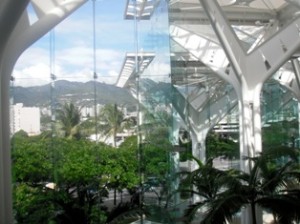 Now the real SAF convention starts. We got up early next morning, anticipating all the stuff we were about to learn. The keynote speaker was great! It was Nainoa Thompson of the Polynesian Voyaging Society. It was an inspirational speech about learning, history, and perseverance associate with sailing primitive canoes around the world. Their objective is to install values of life and personify connection between natural and human resources. The voyage is an analogy for the earth. We could relate. We were on a voyage from Raleigh into the wilderness where we had to carry all our resources on our backs. We didn’t even have a boat. Our awareness of water, food, shelter and our companions on this trip was parallel to what the Polynesians were experiencing. For example, we brought with us 5 bottles of iodine tablets for water purification. That is enough for 63 litters of water, by the 3 day we realized that we were over consuming our water supply and that we needed to conserve. We rationed out the rest of the water, recognizing that some of us needed more than others to function.
Now the real SAF convention starts. We got up early next morning, anticipating all the stuff we were about to learn. The keynote speaker was great! It was Nainoa Thompson of the Polynesian Voyaging Society. It was an inspirational speech about learning, history, and perseverance associate with sailing primitive canoes around the world. Their objective is to install values of life and personify connection between natural and human resources. The voyage is an analogy for the earth. We could relate. We were on a voyage from Raleigh into the wilderness where we had to carry all our resources on our backs. We didn’t even have a boat. Our awareness of water, food, shelter and our companions on this trip was parallel to what the Polynesians were experiencing. For example, we brought with us 5 bottles of iodine tablets for water purification. That is enough for 63 litters of water, by the 3 day we realized that we were over consuming our water supply and that we needed to conserve. We rationed out the rest of the water, recognizing that some of us needed more than others to function.
We all selected different presentation to go to. Most were excellent. The one that all the students chose to attend was by Dr. Cubbage. We wanted to show our interest in what he had to say, but in actuality he was very interesting and we were glad we went. For lunch on Thursday, Joanne and Joe Cox took all of us out to lunch even though they knew how hungry we were! That was a real treat. Looking back on the trip it was good to get to know our professors as human beings. We often forget that.
On Thursday night, we went to a hibachi restaurant, and later, some of went into China Town. That evening, we witnessed a murder. Someone across the street from us was shot twice in the chest. We hightailed out of there. The news report the next day said that a government agent associated with the APEC conference was accosted by a “gang banger” and the agent retaliated. So, where is the wilderness now?
Friday we spent the day at the convention. Saturday was our last day in Hawaii. Several of us went to the Arizona Memorial. That was another life changing experience. Our lives are so easy because of the struggles and sacrifices of the past. We owe them so much. Ann Margaret and Lauren walked in the park and talked. The rest of us moped around. Now we had to go. It was such a sad ride back to the airport; we did not want to leave, but we said our goodbyes and headed back to Raleigh.
We enjoyed Hawaii so much and know we will never have an opportunity like this again, being with friends on a voyage into the unknown. The hike was challenging, the convention was inspirational, and we are all proud to say “I did it”. We got to meet great people and have an amazing experience. All of us will forever remember this trip. We are foresters.


